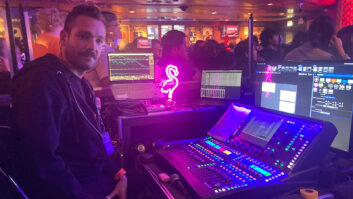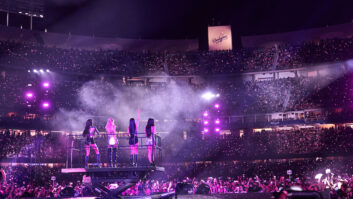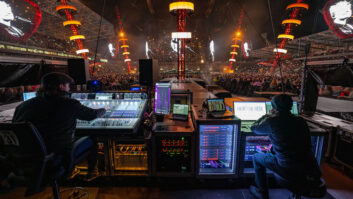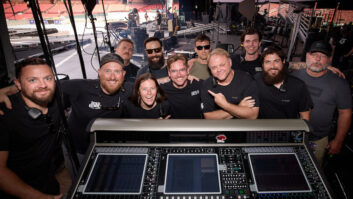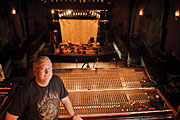
On his first tour with Calexico, FOH engineer Frank Marchand is adapting to house systems.
Indie rock band Calexico (Joey Burns, vocal/guitar; percussionist John Convertino; guitarist Paul Niehaus; keyboardist Jacob Valenzuela, multi-instrumentalist Martin Wenk; and bassist Volker Zander) blend together musical genres from Mexican and Latin music to rock, blues and folk, creating a very danceable and unique sound. It is up to front-of-house engineer Frank Marchand to make sure that the live show reflects the energy that the band exudes onstage.
This is Marchand’s first tour with Calexico, and he is relying on house-provided P.A., console and monitor engineer. For the board, he’s mostly seen Midas models and occasionally a Digidesign. At the Gothic Theater in Denver (where Mix caught up with the act), Marchand mixed on a 25-year-old Soundcraft board that was the monitor desk for the Allman Brothers.
“Whatever they throw me I’ll run with, as long as it works,” says Marchand. “Some venues, they’ll put you in front of gear that they really haven’t had a chance to fix, and that’s the only time I really get leery of what’s going on.”
Marchand prefers to mix in mono because he feels it is important for the audience to hear everything they see onstage. “This is from years ago and seeing a Grateful Dead show,” he says. “I sat facing the left-hand side of the stage and Bruce Hornsby was on the right, and it was panned so hard I did not hear one note of him all night. As a paying customer, you want to hear what you see, and I’m really conscious of that.”
Generally, Marchand builds his mix around Burns and the room. The band has been playing 1,000-seat theaters on this tour, and the rooms can sometimes present challenges. “Managing bottom end is really important,” says Marchand. “It depends on what the room dictates, because a lot of these clubs and theaters have the subs turned up so ungodly loud because they have to address so many different types of music. I’m always turning that stuff way down to get a lot of clarity and to make it not too boomy.

Photos: John Johnston
“These guys are really sensitive to how [Burns’] singing and playing are represented in the acoustic environment of the venue. When we come in for soundcheck, I’m careful to make sure he’s taken care of so he feels comfortable onstage and then I work around that. Sometimes I’ll be turning the subwoofers down, sometimes I’ll be scooping a lot of the mid-frequencies out of the room to give it some clarity. I have an analyzer I bring with me everywhere. I do not use any compression or gating. Because of that dynamic range, I would rather move faders than have processing take care of that.”
Marchand hasn’t been using many effects on this tour except for a couple of reverbs and a band-supplied Roland Space Echo to create a dub feel on some songs. However, he does use a lot of highpass filters: “When I have 25 mics wide open onstage, I’m trying to get rid of stage rumble from the ground and subwoofers to keep the mix clear,” says Marchand. “These guys play so many different instruments, everything needs to have its place, so I get rid of unnecessary frequencies to keep the mix clear.”
About the only gear Marchand provides are mics to ensure some consistency. “If I could put a hypercardioid-type mic on everything, I would do it just to get signal-to-source separation from what you’re trying to put in the P.A. With live sound, the reason I use a lot of dynamic mics is because they’re much more directional and can handle the volume easier. The stage is full of monitor interference and bleed from the P.A. and ambience; it never goes away. Most of the time I’ll use Shure mics wherever I can; they’re not overly bright. The guys are singing through Shure SM58s and Beta 58s. The only mic I really use all the time is the Heil PR 40 on kick drum. This microphone is really even and it’s not boomy-sounding or too pointed or sharp, and all I need to do is a little scooping and it generally represents what’s put in front of it.”
For the seven monitor mixes onstage, “I flip stuff in and out of polarity,” he says, “but generally once the band is dialed in, we’re in good shape. Sometimes I’ll ask the monitor engineer to get rid of a few things that are competing with what’s going on out front.”
Candace Horgan is a Denver-based writer.




